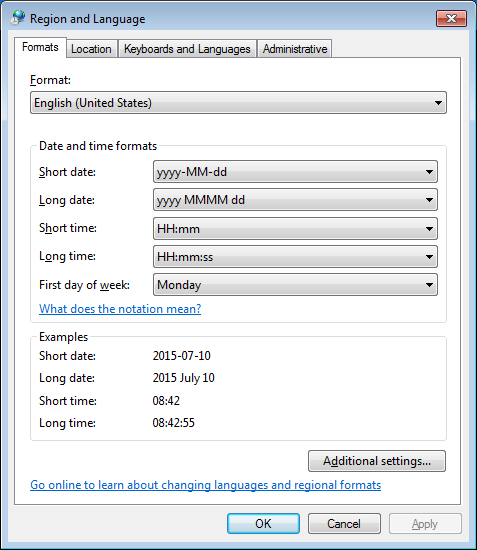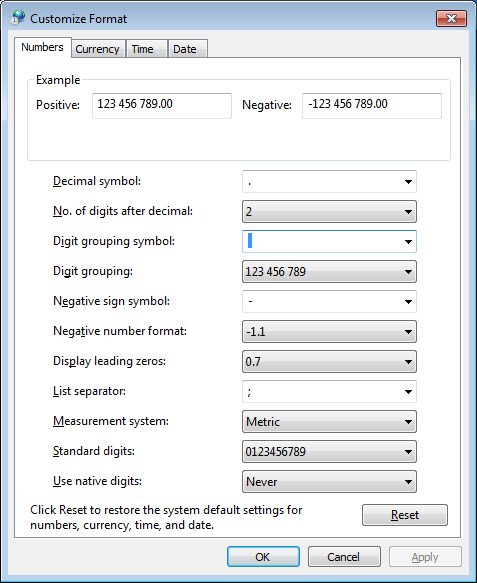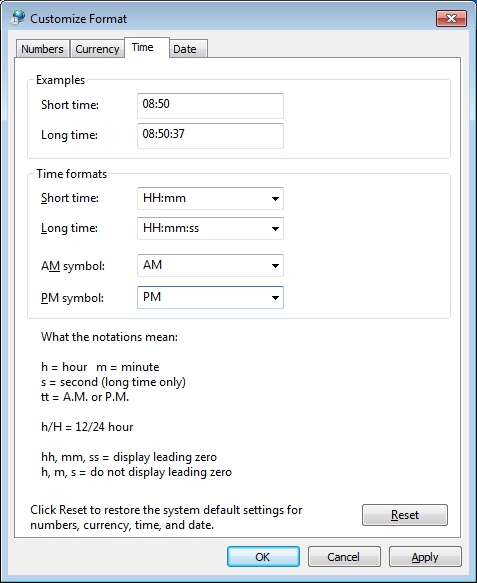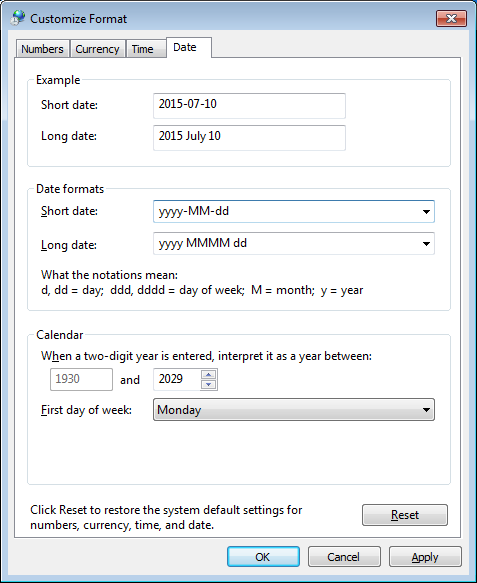ISO Windows
Many people like to fit in. Those who do, observe standards. They prefer writing tuna fish to writing toona phish. If you like to fit in, please continue reading.
The standard way of writing a date is 2026-01-21. The standard way of writing a time is the 24 hour clock. The standard way of writing a distance is using meters. The following script will tell your Microsoft Windows computer to fit in.
Save this the link below, open the file to join the club. Some browsers may allow you to simply click the link. Some changes may only take effect after a reboot.
| isoWindows.reg |
Settings by hand

Click additional settings
 |
 |
 |
 |
Most choices follow ISO 80 000 or ISO 8601. Note that the digit grouping symbol is not a space (' ') but a thin space (' '). The long date is not in ISO 8601 but using a big endian format is consistent with ISO 8601. For currency I use the Dutch convention.
Technical details
The link above links to a UCS-2, Little Endian, Microsoft line endings, Microsoft BOMmed version of the following text.
��W�i�n�d�o�w�s� �R�e�g�i�s�t�r�y� �E�d�i�t�o�r� �V�e�r�s�i�o�n� �5�.�0�0� � � � �[�H�K�E�Y�_�C�U�R�R�E�N�T�_�U�S�E�R�\�C�o�n�t�r�o�l� �P�a�n�e�l�\�I�n�t�e�r�n�a�t�i�o�n�a�l�]� � �;� �h�t�t�p�:�/�/�t�e�c�h�n�e�t�.�m�i�c�r�o�s�o�f�t�.�c�o�m�/�e�n�-�u�s�/�l�i�b�r�a�r�y�/�c�c�7�8�2�6�5�5�%�2�8�v�=�w�s�.�1�0�%�2�9�.�a�s�p�x� � �;� �n�o�t�e� �t�h�a�t� �w�i�n�d�o�w�s� �r�e�q�u�i�r�e�s� �U�C�S�-�2� �l�i�t�t�l�e� �e�n�d�i�a�n� �o�r� �a�s�c�i�i� �a�s� �e�n�c�o�d�i�n�g� � �;� �l�o�c�a�l�e� �s�h�o�u�l�d� �c�o�n�f�o�r�m� �t�o� �s�o�f�t�w�a�r�e� �v�e�r�s�i�o�n� � �;�"�L�o�c�a�l�e�"�=�"�0�0�0�0�0�4�0�9�"� � �;�"�L�o�c�a�l�e�N�a�m�e�"�=�"�e�n�-�U�S�"� � �;�"�s�C�o�u�n�t�r�y�"�=�"�U�n�i�t�e�d� �S�t�a�t�e�s�"� � �;�"�s�C�u�r�r�e�n�c�y�"�=�"�� "� � �;� �I�S�O� �8�6�0�1� � �"�s�D�a�t�e�"�=�"�-�"� � �;� �I�S�O� �8�0� �0�0�0� �a�l�l�o�w�s� �e�i�t�h�e�r� �.� �o�r� �,� � �"�s�D�e�c�i�m�a�l�"�=�"�.�"� � �;� �I�S�O� �8�0� �0�0�0� � �"�s�G�r�o�u�p�i�n�g�"�=�"�3�;�0�"� � �;� �d�o� �n�o�t� �u�s�e� �'�.�'� �o�r� �'�,�'�,� �a�s� �t�h�e�s�e� �a�r�e� �r�e�s�e�r�v�e�d� �b�y� �I�S�O� �8�0� �0�0�0� � �"�s�L�i�s�t�"�=�"�;�"� � �;� �b�i�g� �e�n�d�i�a�n�,� �c�o�n�s�i�s�t�e�n�t� �w�i�t�h� �I�S�O� �8�6�0�1� � �"�s�L�o�n�g�D�a�t�e�"�=�"�y�y�y�y� �M�M�M�M� �d�d�"� � �;� �I�S�O� �8�0� �0�0�0� �a�l�l�o�w�s� �e�i�t�h�e�r� �.� �o�r� �,� � �"�s�M�o�n�D�e�c�i�m�a�l�S�e�p�"�=�"�.�"� � �;� �e�v�e�r�y� �t�h�r�e�e� �d�i�g�i�t�s�,� �I�S�O� �8�0� �0�0�0� � �"�s�M�o�n�G�r�o�u�p�i�n�g�"�=�"�3�;�0�"� � �;� �t�h�i�n� �s�p�a�c�e�,� �I�S�O� �8�0� �0�0�0� � �"�s�M�o�n�T�h�o�u�s�a�n�d�S�e�p�"�=�"� "� � �"�s�N�a�t�i�v�e�D�i�g�i�t�s�"�=�"�0�1�2�3�4�5�6�7�8�9�"� � �;� �I�S�O� �8�0� �0�0�0� � �"�s�N�e�g�a�t�i�v�e�S�i�g�n�"�=�"�-�"� � �;� �I�S�O� �8�0� �0�0�0� � �"�s�P�o�s�i�t�i�v�e�S�i�g�n�"�=�"�"� � �;� �I�S�O� �8�6�0�1� � �"�s�S�h�o�r�t�D�a�t�e�"�=�"�y�y�y�y�-�M�M�-�d�d�"� � �;� �I�S�O� �8�0� �0�0�0� � �"�s�T�h�o�u�s�a�n�d�"�=�"� "� � �;� �I�S�O� �8�6�0�1� � �"�s�T�i�m�e�"�=�"�:�"� � �;� �I�S�O� �8�6�0�1� � �"�s�S�h�o�r�t�T�i�m�e�"�=�"�H�H�:�m�m�"� � �;� �I�S�O� �8�6�0�1� � �"�s�T�i�m�e�F�o�r�m�a�t�"�=�"�H�H�:�m�m�:�s�s�"� � �;� �b�i�g� �e�n�d�i�a�n�,� �c�o�n�s�i�s�t�e�n�t� �w�i�t�h� �I�S�O� �8�6�0�1� � �"�s�Y�e�a�r�M�o�n�t�h�"�=�"�y�y�y�y� �M�M�M�M�"� � �;� �d�i�s�p�l�a�y� �c�u�r�r�e�n�c�y� �s�y�m�b�o�l� �b�e�f�o�r�e� �c�u�r�r�e�n�c�y� �w�i�t�h� �s�p�a�c�e� � �"�i�C�u�r�r�e�n�c�y�"�=�"�2�"� � �;� �Y�e�a�r�,� �m�o�n�t�h� �,� �D�a�y� �(�b�i�g� �e�n�d�i�a�n�)� � �"�i�D�a�t�e�"�=�"�2�"� � �;� �d�i�g�i�t� �s�h�a�p�e� �f�o�l�l�o�w�s� �f�r�o�m� �l�o�c�a�l�e� � �"�N�u�m�S�h�a�p�e�"�=�"�1�"� � �;� �M�o�n�d�a�y�,� �I�S�O� �8�6�0�1� � �"�i�F�i�r�s�t�D�a�y�O�f�W�e�e�k�"�=�"�0�"� � �;� �F�i�r�s�t� �T�h�u�r�s�d�a�y� �i�s� �i�n� �f�i�r�s�t� �w�e�e�k�,� �I�S�O� �8�6�0�1� � �"�i�F�i�r�s�t�W�e�e�k�O�f�Y�e�a�r�"�=�"�2�"� � �;� �0�.�1� �i�n�s�t�e�a�d� �o�f� �.�1�,� �I�S�O� �8�0� �0�0�0� � �"�i�L�Z�e�r�o�"�=�"�1�"� � �;� �S�.�I�.�,� �I�S�O� �8�0� �0�0�0� � �"�i�M�e�a�s�u�r�e�"�=�"�0�"� � �;� �$�-�3�.�0�0� � �"�i�N�e�g�C�u�r�r�"�=�"�2�"� � �;� �-�3�,� �I�S�O� �8�0� �0�0�0� � �"�i�N�e�g�N�u�m�b�e�r�"�=�"�1�"� � �;� �A�4�,� �I�S�O� �2�1�6� � �"�i�P�a�p�e�r�S�i�z�e�"�=�"�9�"� � �;� �2�4� �h�o�u�r� �c�l�o�c�k�,� �I�S�O� �8�6�0�1� � �"�i�T�i�m�e�"�=�"�1�"� � �;� �l�e�a�d�i�n�g� �z�e�r�o�s� �f�o�r� �h�o�u�r�s�,� �I�S�O� �8�6�0�1� � �"�i�T�L�Z�e�r�o�"�=�"�1�"� � � � �;�[�H�K�E�Y�_�C�U�R�R�E�N�T�_�U�S�E�R�\�C�o�n�t�r�o�l� �P�a�n�e�l�\�I�n�t�e�r�n�a�t�i�o�n�a�l�\�G�e�o�]� � �;� �N�e�t�h�e�r�l�a�n�d�s� � �;�"�N�a�t�i�o�n�"�=�"�1�7�6�"� � � � � � �
UTC
Besides that all computer clocks should be set to UTC, conversion to local time and DST is a locale dependent issue that the computer real time clock should not be bothered with:
[HKEY_LOCAL_MACHINE\SYSTEM\CurrentControlSet\Control\TimeZoneInformation] "RealTimeIsUniversal"=dword:00000001